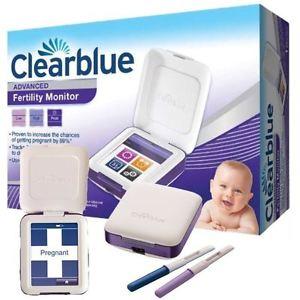The theory behind getting pregnant is relatively simple but, as many people can confirm, putting it into practise isn’t always that straightforward! Contrary to popular belief, you cannot get pregnant at anytime of the month - you will need to be ovulating to conceive and tracking down when in your cycle that happens can be a stressful combination of apps, thermometers and trying to decipher pee-soaked strips of paper.
The Clearblue Advanced Fertility Monitor aims to take away the guessing game by giving you clear information on when you reach your most fertile days. The website describes the monitor as having a discrete and feminine design - as many couples chose to keep their attempts of trying to conceive on the down low, discretion is necessary (you don’t want friends and family adding to the pressure by quizzing you at every event or worse endeavouring to give you advice!)
The device has ‘Clearblue’ embossed across the front and the test strips also have ‘Clearblue’ stamped all over them, so even my guy mates would be able to guess what they are for. As for feminine design I would disagree, but if it was pink and covered in flowers I would be even less happy…there is no pleasing some. The Monitor is the only monitor that tracks and stores fertility and pregnancy information - it tests for the levels of two key fertility hormones: oestrogen and luteinising. It comes with a long instruction manual with a load of do’s and don’ts, which can be really daunting at first; I was so worried about not setting up the cycle on the right day and having to wait until the following cycle.
Basically, you have to set you a new cycle on the first day of your period. You then have a short window of time where you can amend the settings - you will be asked to select a six-hour window to do the test and this will start day six of your cycle. It needs to be the first wee of the day (you can set an alarm on the monitor as a reminder), you then pop the test strip in the monitor and it will read your results before displaying it clearly on the screen. Your results will tell you if your chances of conception are either Low, High or Peak, then after the dreaded two weeks wait you can test for pregnancy as early as three days before your predicted period.
The monitor has a touch screen which isn’t that sensitive. You can input some very basic information, like when you are on your period and if you have had sex (the apps out there let you add much more data) - you can look at the last six months of your data but no more.
I tested out the Clearblue Advanced Fertility Monitor and here is a quick break down of my thoughts: the instruction manual could be clearer (it almost fills you with apprehension), the monitor’s display could be more responsive, the menus and options are easy to use and intuitive but dated and basic, with limited options to input your own data. Taking the tests is easy. Although trying to open one of those packets when you are busting for a wee can be quite stressful, I eventually found it easier to take a sample and dip the stick in rather than pee directly on it, as you can use your phone to time 15secs without the fear of dropping your phone down the loo. I use a FitBit app and a free app to track my cycles and the Clearblue detected that I had peaked two days after the other apps predicted it. This information would be vitally important if I was trying to conceive, because if I followed the apps chances are we wouldn’t attempt to try on my peak day, as I would be under the impression it was too late.
Once you get to grips with all the rules and timings this fertility monitor is straightforward to use, and it takes away all the guesswork from reading the cheaper paper tests or tracking temperatures. My biggest gripe is the expense: the unit itself is between £70-£80, which is forgivable, but the replacement sticks are just shy of £30 for a box of twenty! If you ovulate later in your cycle you can easily use the entire box, as the machine will ask for test in sets of 10 even after you have peaked, which is a waste of tests and money. There is also a rule about only using 10 sticks in a row with the same batch code, suggesting that if you have less than 10 left over in the box they are useless. This all means that with couples taking between one and two years to conceive, you have to potentially shell out £800! If you have bags of cash and don’t find the process of analysing your cycle adds pressure, this could simplify tracking and testing and potentially increase your odds of conception. RRP £79.95
4 out of 5
Pros
Straight forward daily use
Clear display of results
Accurate results
Can help improve chances of conception
Tracks up to 6months of data
Cons
Can become very expensive
Lots of dos and don’ts
Limited personal data input options
Outdated display
Branding on sticks and machine could be more discrete
- Log in to post comments

